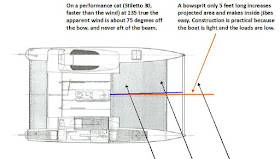I thought about adding one to my PDQ. I really did, after seeing all the pretty ones at the boat show. I had the surplus parts all lined up to build a good one for $20. Then I came to my senses, realized they are nothing more than marketing bollox, and perfect my bridle instead.
I do understand why they exist. My first boat, a souped-up beach cat, had one to carry a chute, and the boat was considerably faster than the wind. Even reaching deep downwind, the apparent wind remained forward of the bow. Jibing through 90 degrees I would actually tack, with the eye of the wind coming from in front of the boat, not from behind. Same with my Stiletto. Fast boats.
A bowsprit increases projected area, allows a larger chute, and most importantly, it provides enough separation between the spinnaker tack and forestay for fast inside jibes (remember, these boats actually tack down wind).
But the math on a cruising cat, even a relatively fast one is very different. The fastest course down wind moves the apparent wind well aft. Jibes are outside because the apparent wind moves astern when jibing. Thus, a bridle provides more projected area and reduces the chance of running your sheets over mid-jibe. It is also lighter, does not contribute to pitching, and does not pound through waves up wind.
(With a bowsprit that long, the sheets are way out there. Just a little slack, the lazy sheet goes in the water, and a second later it is around the keel. Catamarans are less prone to this because the broad bows catch the sheets.)
This is what you actually need. Lighter, faster, stronger, cheaper. All the good words.
(Excerpt from up-coming book on Cruising Faster.)


(Reader Comment)
ReplyDelete"Gday.
I read your post on prodders and thought you may like my take on them. I don't use a prodder for my spinnakers but I like my short prodder for my reacher. At true angles of between 100-150 degrees the prodder works very well. I especially like the reacher with prodder when broad reaching. Then the reacher can take a 135 true angle and turn it into a 90 degree apparent. This means that the prodder does increase projected area and make the boat sail faster. Your diagram has an apparent of about 150 which is almost square running with apparent included. So, think about a prodder, with a reacher. It allows you to set a nice big sail which can take a large range of angles.
Cheers"
I agree! Prodders (bowsprits) are great for reachers--I had them on two fast boats, as indicated. Reachers are used at lower apparent wind angles, and like the Stiletto example, present the most projected area. My point is that prodders are not very good at delivering projected area when sailing deep with a chute on a cruising cat.
Which is better, a reacher, or chute? It depends on the boat. In my case, I have a big genoa, so the added area of a reacher is not so great, and I would always have the extra windage of the furled sail on the stay (unless I took it down, which eliminates much of the convenience). A chute, on the other hand, will sail deeper angles. But for boats with smaller genoas and boats that reach more often than they run, a reacher is a great choice. They are easier to jibe and less scary when the wind comes up (potentially easier to douse--though I'm not sure of that--furling in a blow can suck). A chute does require a few more skills, but I think they are worth learning.
Bow sprits have great use with the Code 0 on cruising cats, right? .. So that's why! (Answering your question )
ReplyDeleteI have one on my F-24 for that reason, and it works.
ReplyDelete